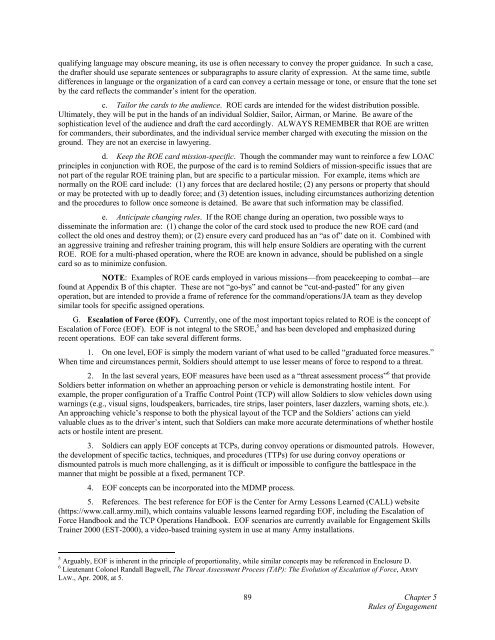The Law of War
The Law of War
The Law of War
You also want an ePaper? Increase the reach of your titles
YUMPU automatically turns print PDFs into web optimized ePapers that Google loves.
qualifying language may obscure meaning, its use is <strong>of</strong>ten necessary to convey the proper guidance. In such a case,<br />
the drafter should use separate sentences or subparagraphs to assure clarity <strong>of</strong> expression. At the same time, subtle<br />
differences in language or the organization <strong>of</strong> a card can convey a certain message or tone, or ensure that the tone set<br />
by the card reflects the commander’s intent for the operation.<br />
c. Tailor the cards to the audience. ROE cards are intended for the widest distribution possible.<br />
Ultimately, they will be put in the hands <strong>of</strong> an individual Soldier, Sailor, Airman, or Marine. Be aware <strong>of</strong> the<br />
sophistication level <strong>of</strong> the audience and draft the card accordingly. ALWAYS REMEMBER that ROE are written<br />
for commanders, their subordinates, and the individual service member charged with executing the mission on the<br />
ground. <strong>The</strong>y are not an exercise in lawyering.<br />
d. Keep the ROE card mission-specific. Though the commander may want to reinforce a few LOAC<br />
principles in conjunction with ROE, the purpose <strong>of</strong> the card is to remind Soldiers <strong>of</strong> mission-specific issues that are<br />
not part <strong>of</strong> the regular ROE training plan, but are specific to a particular mission. For example, items which are<br />
normally on the ROE card include: (1) any forces that are declared hostile; (2) any persons or property that should<br />
or may be protected with up to deadly force; and (3) detention issues, including circumstances authorizing detention<br />
and the procedures to follow once someone is detained. Be aware that such information may be classified.<br />
e. Anticipate changing rules. If the ROE change during an operation, two possible ways to<br />
disseminate the information are: (1) change the color <strong>of</strong> the card stock used to produce the new ROE card (and<br />
collect the old ones and destroy them); or (2) ensure every card produced has an “as <strong>of</strong>” date on it. Combined with<br />
an aggressive training and refresher training program, this will help ensure Soldiers are operating with the current<br />
ROE. ROE for a multi-phased operation, where the ROE are known in advance, should be published on a single<br />
card so as to minimize confusion.<br />
NOTE: Examples <strong>of</strong> ROE cards employed in various missions—from peacekeeping to combat—are<br />
found at Appendix B <strong>of</strong> this chapter. <strong>The</strong>se are not “go-bys” and cannot be “cut-and-pasted” for any given<br />
operation, but are intended to provide a frame <strong>of</strong> reference for the command/operations/JA team as they develop<br />
similar tools for specific assigned operations.<br />
G. Escalation <strong>of</strong> Force (EOF). Currently, one <strong>of</strong> the most important topics related to ROE is the concept <strong>of</strong><br />
Escalation <strong>of</strong> Force (EOF). EOF is not integral to the SROE, 5 and has been developed and emphasized during<br />
recent operations. EOF can take several different forms.<br />
1. On one level, EOF is simply the modern variant <strong>of</strong> what used to be called “graduated force measures.”<br />
When time and circumstances permit, Soldiers should attempt to use lesser means <strong>of</strong> force to respond to a threat.<br />
2. In the last several years, EOF measures have been used as a “threat assessment process” 6 that provide<br />
Soldiers better information on whether an approaching person or vehicle is demonstrating hostile intent. For<br />
example, the proper configuration <strong>of</strong> a Traffic Control Point (TCP) will allow Soldiers to slow vehicles down using<br />
warnings (e.g., visual signs, loudspeakers, barricades, tire strips, laser pointers, laser dazzlers, warning shots, etc.).<br />
An approaching vehicle’s response to both the physical layout <strong>of</strong> the TCP and the Soldiers’ actions can yield<br />
valuable clues as to the driver’s intent, such that Soldiers can make more accurate determinations <strong>of</strong> whether hostile<br />
acts or hostile intent are present.<br />
3. Soldiers can apply EOF concepts at TCPs, during convoy operations or dismounted patrols. However,<br />
the development <strong>of</strong> specific tactics, techniques, and procedures (TTPs) for use during convoy operations or<br />
dismounted patrols is much more challenging, as it is difficult or impossible to configure the battlespace in the<br />
manner that might be possible at a fixed, permanent TCP.<br />
4. EOF concepts can be incorporated into the MDMP process.<br />
5. References. <strong>The</strong> best reference for EOF is the Center for Army Lessons Learned (CALL) website<br />
(https://www.call.army.mil), which contains valuable lessons learned regarding EOF, including the Escalation <strong>of</strong><br />
Force Handbook and the TCP Operations Handbook. EOF scenarios are currently available for Engagement Skills<br />
Trainer 2000 (EST-2000), a video-based training system in use at many Army installations.<br />
5 Arguably, EOF is inherent in the principle <strong>of</strong> proportionality, while similar concepts may be referenced in Enclosure D.<br />
6 Lieutenant Colonel Randall Bagwell, <strong>The</strong> Threat Assessment Process (TAP): <strong>The</strong> Evolution <strong>of</strong> Escalation <strong>of</strong> Force, ARMY<br />
LAW., Apr. 2008, at 5.<br />
89 Chapter 5<br />
Rules <strong>of</strong> Engagement

















